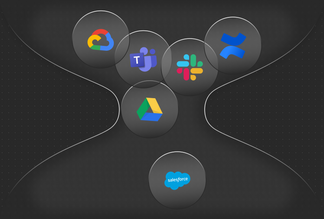

6 tips on effectively leading distributed teams
The workplaces of yesterday are gone. Today, teams are made up of individuals who are remote, in-person, or a combination of both. Employees have moved across the country to be closer to family, others have joined your company from across the globe thanks to new remote-friendly policies. Some have stayed right where they are and continue to commute two days out of the week.
Your team is now distributed, composed of employees who work from all over the world rather than being centralized within a physical office.
They are no longer obligated to show up at 9 a.m. but rather asked to engage fully and be productive independently. A manager’s responsibility to their team has shifted as well, mainly to make the former possible for distributed knowledge workers.
Maintaining connectivity and context around work are the pillars of a high-caliber distributed workforce. To achieve this, we’ve armed our organizations with hundreds of apps — Slack, Asana, Microsoft Teams, Google Drive, etc. However, our technological solutions weren’t built by the same teams, and aren’t well-adapted to converse with each other.
The way we work needs an upgrade. As we dive further into the future of distributed teams through hybrid models, it's important to acknowledge the areas we still need to improve. According to GitLab's 2021 Remote Work Report, only 37% of respondents say their organization does a good job aligning work across projects — making leading all the more difficult.
What is the difference between distributed and remote?
The differentiator between remote work and distributed work is that remote work is for the individual worker. Distributed work is a characteristic of the organization. Distributed work contains remote work, kind of like how all squares are rectangles but not all rectangles are squares.
Challenges distributed teams face
A study of knowledge workers from The Economist Intelligence Unit commissioned by Dropbox found that distractions take up nearly a third of all working hours in the US, at an annual cost of $391 billion. This directly correlates to the idea of the “hyperactive hive mind,” coined by Cal Newport.
The hyperactive hive mind refers to the unstructured conversations on messaging apps and meetings that don’t allow space for us to get any real work done. These conversations are born from a lack of visibility, transparency, digital dexterity, and effective methods of communication.
Many of these messages also result from siloed information and limited accessibility to tools or documents. Think about the last time you had to ping a co-worker about a project brief or to get permissions into a doc. With mass distributed work, tools that provide context reduce the need to heavily rely on conversational interfaces such as instant messaging, email, and video conferences.
In addition to these challenges, the isolation of a distributed worker directly impacts an employee’s experience. Employee engagement can be tricky when teams aren’t connected through a mutual space, and preserving company culture often becomes sidelined in order to deal with the previously mentioned organizational issues.
The bottom line is this: As a workforce, we’re disjointed and scattered. We spend too much time context-switching and struggle to get a sense of belonging at work. But there are ways for management to address these problems, and they begin here.
6 tips on leading distributed teams
-
Embrace a combination of asynchronous and synchronous communication
A lot of the pains we experience with distributed work come from an imbalance of async and sync communication.
Asynchronous communication refers to “different place-different time” collaboration where people communicate when convenient. Synchronous communication happens in real-time, where people communicate with immediacy.
Most organizations rely heavily on synchronous communication. It’s what we’re used to. But this leads to ineffective meetings, responding to instant messages instead of focusing, and prioritizing the speed of collaboration rather than the outcome.
Asking a co-worker to do a quick Zoom sync on the status of a Clubhouse ticket may seem like an effective use of time, but imagine having more calls concerning questions that could have been answered if the task already included the context you were looking for. No matter how “quick” a meeting is, they require everyone to be available at the same time and interrupt valuable flow time. Here, written status updates are a good solution. This can be done with any async tool, but there are great Slack bots that do just this.
To move your team toward a more async-friendly model, put them in charge of their own productivity and focus time — and honor it. Establish flexibility with responses, and give people the freedom to return to a message once they’ve completed what they’re working on. Don’t measure who’s constantly online, measure what gets done.
-
Prioritize transparency
Prioritizing transparency can mean a lot of things in the business world. A transparent leadership team could keep their revenues, customer expenditures, and venture capital financing information completely open for the sake of transparency — like Buffer does.
An employee can add their managers and co-workers to any and all docs they’re currently working in to allow for discoverability and reduce sync time.
A manager can prioritize transparency within their team by encouraging them to come forward with issues, roadblocks, and problems to ensure everyone is swimming laps, not drowning in work.
Teams can post project updates, complete with reporting and links to planning documents, on the company wiki or work hub to allow for company-wide visibility.
When it comes to distributed teams, prioritizing transparency is about giving context, encouraging communication, and providing visibility so everyone feels connected within the company. Nobody is left out of the loop or scrambling to find the answer to a question because it’s all been made readily available.
As a team leader, giving your team the bigger picture is a good place to start. Make sure everyone on the team knows what each person is working on and how they fit together to make one giant puzzle.
-
Establish engagement practices
HubSpot’s Katie Burke said it best, culture is not tied to location. It’s rooted in your values, employees, and mission.
For a long time, employee engagement practices and culture-building were built around what amenities an office could offer you, especially in tech. And yes, free catered lunches, a gym, and fantastic swivel chairs are all things that make going to work a little better. But in today’s world, we have to create that environment without having a physical location to lean back on.
This comes directly from how people-first your culture is. If your employees sense that they aren’t valued, they aren’t going to actively participate in ways that allow them to grow. The value you place in your employees comes back through a feedback loop, so here are some tips to establish engagement practices from the top down.
- Offer great benefits. Budgeting for competitive benefits shows that your company is ready to put their money where their mouth is. Investing in your employees’ health and happiness from the start is an important impression to leave.
- Establish a calendar for virtual employee experiences. You can either pay for virtual experiences for your team (The Qatalog team recently did a coffee masterclass through Airbnb), or ask your employees to volunteer. If your co-worker has perfected their shakshuka recipe, have them walk through a masterclass of it and provide a list of ingredients for everyone to purchase beforehand.
- Start employee resource groups. ERGs are employee-led groups that empower and support community groups within a company. Building ERGs directly impacts your culture by supporting the diverse makeup of your organization and giving power back to your employees on policies that impact them directly, like hiring and community issues.
-
Celebrate the small (and big) wins
One of the best practices for increasing engagement and retention is making sure your team’s work is appreciated. And when leadership is focused on the wins, there’s likely to be less micromanaging – which can be detrimental to a knowledge worker’s remote experience.
Making sure the wins on your team are noticed will also enhance ownership of projects. Here at Qatalog, we post a lot of our projects on the company’s work hub, so that everyone can see what everyone is up to. Not only does this allow us to celebrate the wins across teams, it increases company-wide transparency.
Here are some actionable tips for celebrating your team’s wins:
- Showcase your team’s work, or give them the opportunity to do so in company all-hands meetings.
- Save time each month to go over what the team accomplished, and any constructive criticism that enables them to grow.
- Send a quick message if someone’s work has been impactful.
- Give your team space and resources they need to celebrate and support each other. On the Qatalog marketing team, we have a standup Slack bot that we use to shout out team members’ work on Wednesdays and Fridays.
-
Adapt to team needs
A team is a collective built of diverse individuals. Every person has a different style of working, communicating, and relaxing, which can make leading them difficult if you’re also spread across time zones and languages.
It’s a challenge. But it also leads to greater diversity. Teams aren’t made up of cogs in a machine that produce great work every minute from 9-5. What could be considered disrupted operations and fragmented environments are actually enriching to the work experience, and providing your company with different outlooks and perspectives that it could have never accomplished if everyone was hired from the same neighborhood.
It’s up to you to adopt a more personal approach to management in order to have a greater awareness of the personalities on your team. Identifying each individual’s habits and routines will help you to build meeting schedules that work for everyone.
Identifying habits will also help you discern when an employee is having a difficult time. If their video camera is off for conference calls more than usual or they’re having a hard time focusing, ask them if they need help without making assumptions or judgments.
-
Find tech that works for you
The tools you use to communicate and collaborate with your distributed team shouldn’t add stress or chaos to your workday.
In 2019, the average office worker had 5 or more apps open at any given time. In 2020, many workplace apps saw an increase of over 200% YOY including Figma, Miro, and Amazon Business. It’s safe to say that workplace apps are the cornerstone of workplace productivity and yet, going back to that hyperactive hive mind idea, they aren’t working for us.
There are apps for creating projects with teams, for managing those projects, for messaging and video chatting about progress — and no underlying connection or language between them.
That’s why distributed teams need a work hub, a place where people, work, and tools connect in a transparent and complementary way.
At Qatalog, our work hub is at the center of everything we do. We log projects, progress, attach documents, schedule meetings, and outline goals from one place. It’s hard to believe that at some point, we all worked in a completely different way.
Wrap up: How to lead distributed teams
We’re all learning as we go. Managing a distributed team is new territory for most of us. And while distributed work has provided a lot of flexibility, it’s also led to a lot of siloed work and disconnect that can feel unsustainable long-term.
Here’s the thing, distributed work is here to stay. And according to Microsoft’s survey on hybrid work, leaders are out of touch with their employees and need a wake-up call. The way out is through authenticity, acknowledging the struggles your team is facing, and connecting with each other on a human level to create an environment where everyone thrives.


